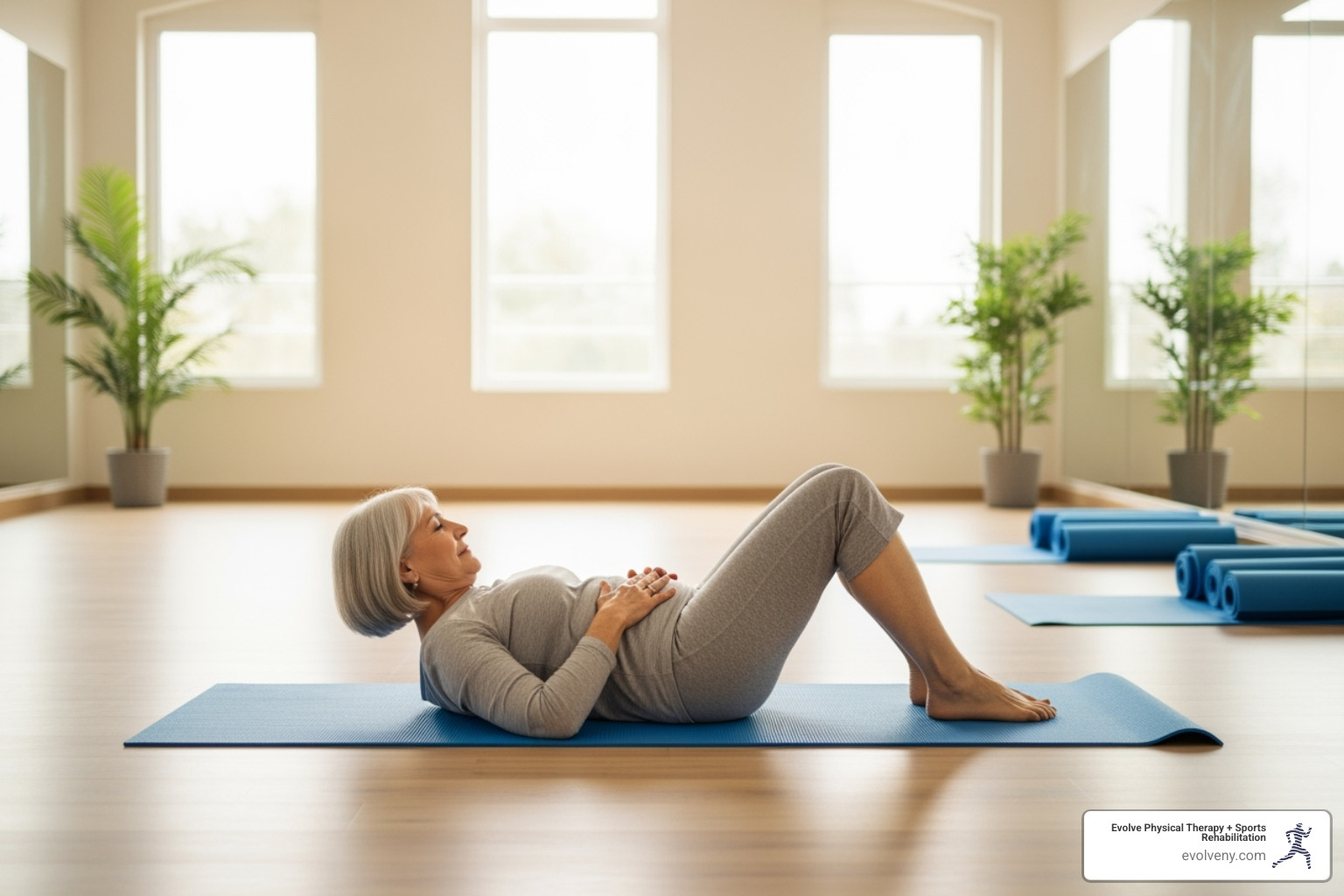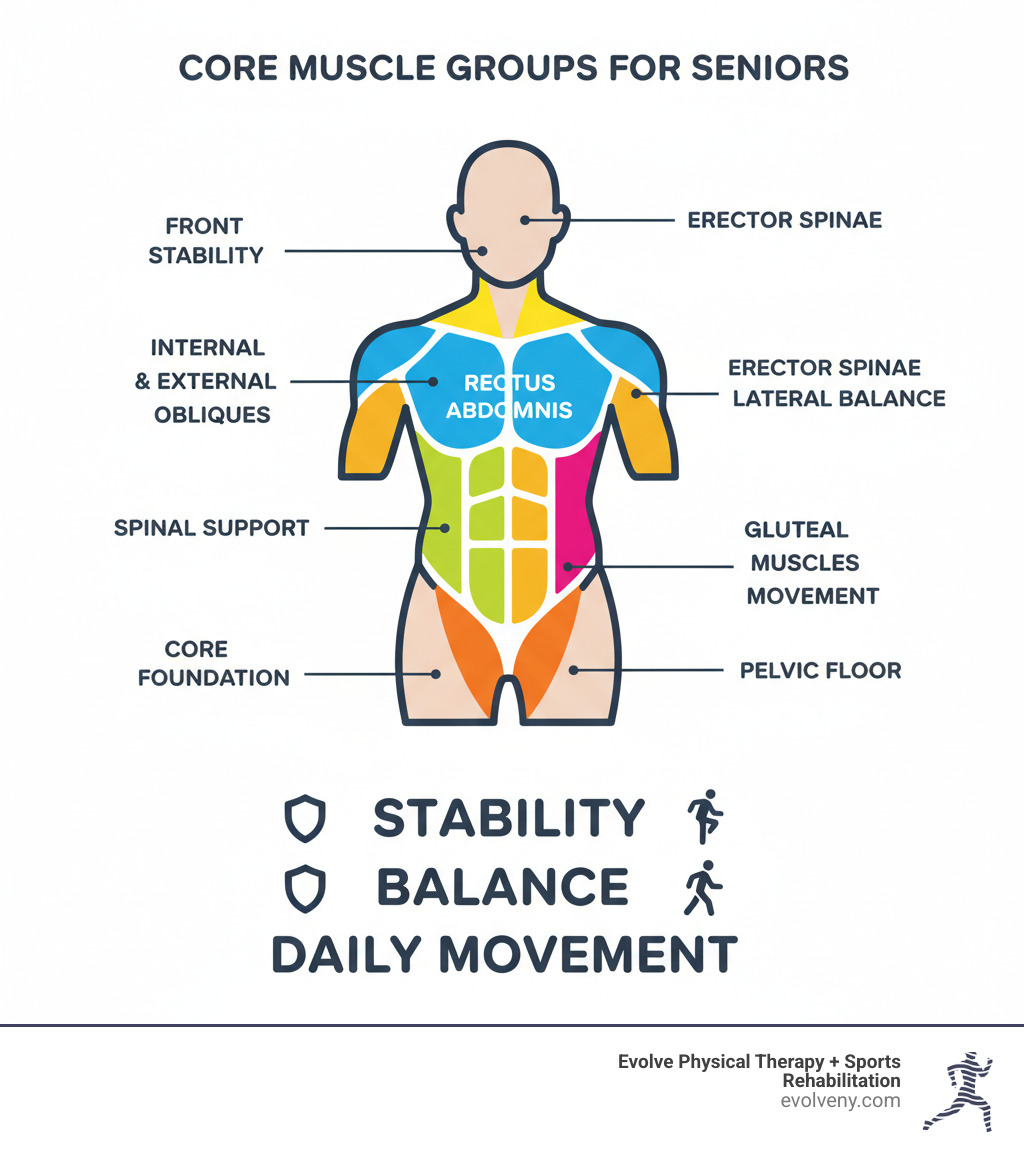How Seniors Can Strengthen Their Core and Confidence
Why Core Strength Matters More as You Age

Core strength for seniors is not just about having a flat stomach; it's the bedrock of your ability to move safely, maintain balance, and live an independent, active life. As we age, preserving this strength becomes one of the most important things we can do for our overall health and well-being.
Quick Answer: The Best Approach to Core Strength for Seniors
- Start with seated exercises like belly breathing and pelvic tilts to build a foundational connection.
- Progress to standing movements using a chair or wall for support to improve balance.
- Practice 2-3 times per week, prioritizing proper form and control over speed or intensity.
- Focus on functional strength that directly translates to easier and safer daily tasks.
- Avoid high-risk movements like traditional sit-ups and crunches that can strain the neck and back.
The statistics on senior falls are alarming: in the United States, a senior falls every 12 seconds. This equates to one in four adults over 65 experiencing a fall each year. Tragically, about 20% of these falls result in serious injuries such as broken bones or head trauma, which can drastically alter one's quality of life. Beyond the physical injury, the fear of falling can lead to a cycle of inactivity, which further weakens muscles and increases fall risk.
However, there is powerful, proactive step you can take. Research has shown that regular core strengthening can reduce fall rates by up to 24% among older adults. This is where understanding your core becomes crucial.
Your core is far more than just your "abs." It's a sophisticated system of deep and superficial muscles that form a 360-degree support structure around your trunk. This includes:
- Abdominals (Rectus Abdominis, Transverse Abdominis): These muscles in the front help you bend forward and, more importantly, the deep transverse abdominis acts like a natural corset, stabilizing your spine.
- Obliques (Internal and External): Located on your sides, these are essential for twisting and side-bending movements.
- Lower Back Muscles (Erector Spinae, Multifidus): These run along your spine and are vital for maintaining an upright posture and controlling backward bending.
- Glutes (Gluteus Maximus, Medius, Minimus): Your buttock muscles are a powerhouse for hip extension and stabilization, which is critical for walking, climbing stairs, and getting up from a chair.
- Pelvic Floor: This sling of muscles at the base of your pelvis supports your organs and works in concert with your diaphragm and deep core muscles to regulate internal pressure and stabilize the spine from below.
Starting around age 30, we all begin to experience a natural decline in muscle mass, a condition known as sarcopenia. We can lose 3-8% of our muscle mass each decade, and this rate accelerates after age 60. The core muscles are particularly susceptible to this age-related weakening, which can lead to a cascade of problems: poor posture, chronic back pain, and a dangerous loss of balance.
A strong core counteracts this decline. It provides the stability to walk confidently on uneven sidewalks, improves your posture to alleviate backaches, and gives you the power to perform daily activities—like getting out of a chair or bending to tie your shoes—with ease and without fear. It is the fundamental component that empowers you to remain active and self-sufficient.
I'm Lou Ezrick, founder of Evolve Physical Therapy. With nearly two decades of experience in Brooklyn, I've dedicated my career to helping thousands of patients, especially seniors, reclaim their strength and confidence. At Evolve, we don't just give you a sheet of exercises. We use a hands-on, manual therapy approach to identify the root cause of your weakness or pain. We then build a personalized, progressive program focused on core strength for seniors that delivers sustainable, real-world results. Our goal is to move you beyond the clinic and back to a life of capability and independence.

Why a Strong Core is Your Foundation for Healthy Aging
Think of your core as the central hub of your body, the foundation of a house. When that foundation is solid, the entire structure is more stable, resilient, and functional. For seniors, reinforcing this foundation is the key to aging with strength, grace, and independence.
The most immediate and life-changing benefit of building core strength for seniors is a dramatic improvement in balance and coordination. Your ability to stay upright is a complex dance between your muscles, your brain's sense of body position (proprioception), and your inner ear's vestibular system. A strong, engaged core provides a stable center of gravity, giving these systems a reliable platform to work from. Research confirms that core stability training significantly improves weight distribution and steadiness in older adults, which directly translates to better balance during both static (standing still) and dynamic (walking) activities.
This improved balance is your number one defense against falls. While the statistic that core exercises can reduce fall rates by up to 24% is impressive, the real-world impact is even more profound. A strong core allows you to make rapid, subconscious adjustments to catch yourself if you trip or lose your footing. It helps break the vicious cycle of fear-of-falling, where a fear of getting hurt leads to decreased activity, which in turn causes more muscle weakness and a higher actual risk of falling. For more in-depth strategies, our guide on physical therapy for fall prevention offers a comprehensive look at staying steady on your feet.
Beyond fall prevention, a strong core is a powerful antidote to chronic back pain. Many older adults suffer from back pain because weak abdominal muscles cause the pelvis to tilt forward, increasing the sway in the lower back and compressing the spinal joints. By strengthening your core muscles, you create a natural "internal corset" that supports your spine. This muscular brace offloads pressure from the vertebrae and discs, corrects postural imbalances that contribute to pain, and reduces the chronic strain on your back muscles. As noted by Harvard Health, strengthening your core is essential for providing this spinal support and combating the tendency to slouch.
Perhaps the most rewarding benefit is how a robust core makes everyday life easier and more enjoyable. These are not small feats; they are the cornerstones of independence. Consider the biomechanics:
- Getting out of a chair: A strong core engages first, stabilizing your trunk so your legs can powerfully and safely push you to a standing position without straining your back.
- Bending to tie shoes: Your core muscles hold your spine in a safe, neutral position, allowing you to bend from the hips and preventing painful disc or muscle strain.
- Carrying groceries: Your core acts as a rigid lever, transferring the load from your arms through your body and into your legs, protecting your spine from dangerous twisting or compression.
- Climbing stairs: A stable core provides the anchor point for your hip flexors and glutes to work efficiently, making each step smoother and less taxing.
These daily victories add up to something invaluable: the freedom to live life on your own terms. It's the confidence to play with your grandchildren, the ability to pursue hobbies like gardening, and the peace of mind that comes from moving through your day without pain or worry. At Evolve Physical Therapy, we see this change every day. When our senior patients commit to building their core strength, they aren't just doing exercises—they are rebuilding the foundation for a more active, engaged, and joyful life.
The Best and Safest Exercises for Core Strength for Seniors
When it comes to building core strength for seniors, the principle of "do no harm" is paramount. Not all exercises are created equal, and many popular core workouts designed for younger athletes can be ineffective or even dangerous for older adults. At Evolve Physical Therapy, our approach prioritizes safety and functional effectiveness, ensuring your efforts build you up without the risk of injury.
The key is to choose exercises that stabilize the spine rather than repeatedly flexing or twisting it under load. Let's compare some common exercise types to understand why certain movements are safer and more beneficial for seniors.
| Exercise Type | Safe for Seniors (Examples) | Risky for Seniors (Examples) | Why It's Risky for Seniors |
|---|---|---|---|
| Spinal Flexion | Seated Marches, Pelvic Tilts (Lying or Seated), Modified Plank | Full Sit-Ups, Double Leg Lifts, Abdominal Crunches | Puts significant strain on the neck muscles, causes excessive rounding (flexion) of the lumbar spine which can compress discs, and often over-activates the hip flexors instead of the deep core. |
| Spinal Rotation | Seated Trunk Twists (Gentle), Standing Unweighted Wood Chops | Weighted "Russian" Twists, Fast-Paced Twisting Crunches | Can create dangerous shearing forces on the vertebrae and spinal discs, especially for those with arthritis or degenerative disc disease. Rapid, uncontrolled twisting is a common mechanism for back injury. |
| Static Stability | Bird-Dog, Bridge, Wall Push-Ups, Modified Plank (on knees or forearms) | Advanced Plank Variations (e.g., with leg lifts), Exercises on Unstable Surfaces (initially) | These require a high level of foundational strength. Attempting them too early can lead to poor form, compensation with the wrong muscles (like the lower back), and potential strain or injury. |
The primary reason we advise against exercises like sit-ups and crunches is the high risk of neck and back strain. When you pull on your head to lift your shoulders off the floor, you place immense pressure on the delicate cervical spine. Furthermore, the repetitive forward-bending motion can exacerbate conditions like osteoporosis or spinal stenosis.
The goal of senior core training should be to create stability. Think of your core's job as preventing motion, not creating it. It needs to hold your spine steady while your arms and legs move. This principle—"proximal stability for distal mobility"—is the foundation of safe and functional movement. A stable core allows you to reach, lift, and walk with control and without putting your spine at risk.
This is why consulting a professional is so important. A physical therapist at Evolve Physical Therapy in Brooklyn can do much more than hand you a list of exercises. We conduct a thorough assessment to understand your unique physical condition, including any pre-existing issues like arthritis, osteoporosis, or past injuries. Based on this evaluation, we design a customized core strengthening program that is perfectly suited to your body and your goals. We provide hands-on guidance to ensure you are activating the correct muscles and using perfect form, which is the secret to getting results safely. We'll help you master the basics and then show you how to progress gradually, so you're always challenging yourself without ever putting yourself in harm's way.

